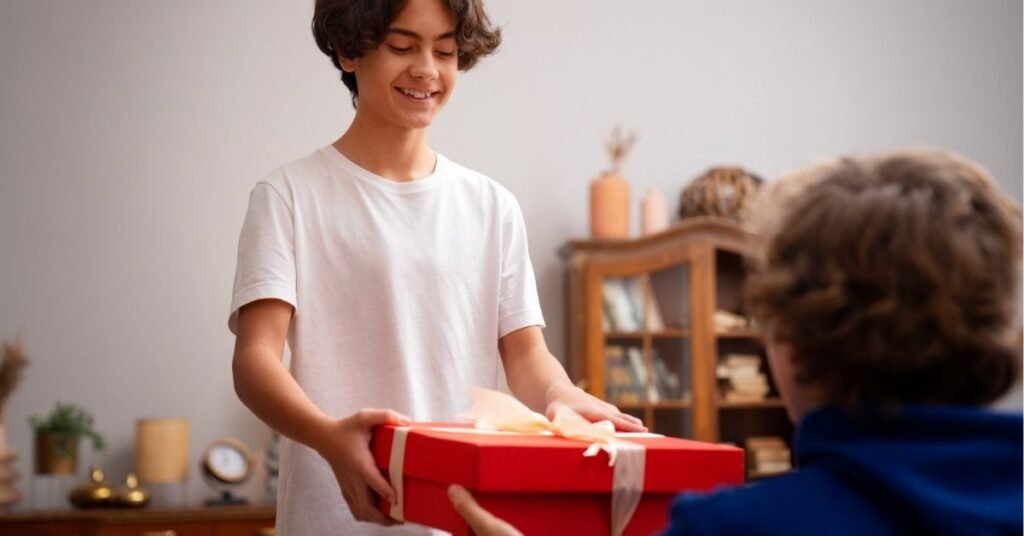Care packages are a small gesture with big returns. A thoughtfully packed box from home can cheer a stressed student during finals, cure homesickness, or celebrate a milestone.
Whether you’re a parent, friend, partner, or roommate, the right care package mixes practical items (study supplies, cozy socks) with emotional boosters (handwritten notes, favorite snacks).
This guide walks you through the best care packages for college students, covering theme ideas, itemized packing lists, step-by-step assembly instructions, shipping and dorm-delivery tips, sustainability options, and a deep dive into socks — a small but surprisingly powerful inclusion.
You’ll finish with ready-to-use checklists and FAQs so you can send a box that lands perfectly.
Quick Answer: The best care packages for college students are themed boxes that mix essentials and comforts:
- Snack & Study Survival Kit (brain fuel + focus tools)
- Self-Care & Wellness Box (comfort items + stress relief)
- Cozy Dorm & Comfort Pack (blanket, socks, mug)
- Practical Dorm Essentials (laundry, toiletries, chargers)
- Care for Finals (highlighters, healthy snacks, instant coffee, earplugs)
Personalize for the receiver, include a handwritten note, and choose shipping that matches the campus rules.
Best Care Packages for College Students
Below are detailed, theme-by-theme care package ideas with full item lists, assembly tips, personalization options, shipping guidelines, and helpful checklists. Use these as templates — mix and match items to reflect the student’s tastes and needs.
1) Snack & Study Survival Kit
Why it works: Food is immediate comfort and study fuel. A balanced mix of healthy and treat snacks helps study stamina and morale.
Ideal for: Exam season, long study weekends, late-night group study sessions.
Pack these items:
- Healthy snacks: mixed nuts, granola bars, trail mix, dried fruit.
- Brain-boosters: dark chocolate, omega-rich seeds (chia), roasted chickpeas.
- Comfort treats: favorite chips, cookies, candy squares.
- Instant beverages: single-serve coffee, tea bags, hot cocoa packets.
- Hydration: a durable reusable water bottle or sachets for infused water.
- Practical study tools: sticky notes, highlighters, index cards, a small notebook, pens.
- Quick comfort: microwave popcorn, instant soup cups (if allowed in dorm).
- A handwritten note or “study playlist” QR code.
Assembly tips: Use sturdy dividers or small containers so fragile snacks don’t get crushed. Add an ice pack or insulated wrap for any chocolate if shipping warm.
2) Self-Care & Wellness Box
Why it works: College can be stressful. Self-care boxes promote mental health and relaxation.
Ideal for: Students who feel overwhelmed, the start of a new term, after illness.
Pack these items:
- Face masks (sheet masks), travel-sized lotion, lip balm.
- Soothing items: lavender sachet, calming tea blends (chamomile), small candle (if allowed), or wax melts.
- Sleep helpers: eye mask, silk pillowcase square, earplugs.
- Movement aids: resistance band, mini yoga strap, mindful breathing card.
- Wellness guidance: a printed mini self-care plan, gratitude journal, or calming coloring book.
- Healthy snack: nuts, herbal tea, dark chocolate.
- Encouragement note: personal letter with coping tips.
Assembly tips: Wrap fragile items (ceramic, glass) in bubble wrap. Use tissue paper and a calming color palette (soft blues/greens). Include instructions for product use.
3) Cozy Dorm & Comfort Pack
Why it works: Dorm rooms can feel sterile. Cozy items make a dorm feel like home.
Ideal for: New students at move-in, birthday gifts, winter term.
Pack these items:
- Soft throw blanket or microplush blanket.
- Warm socks — see sock deep dive below.
- A sturdy ceramic or insulated travel mug.
- String lights (battery-operated) or a small desk lamp.
- Portable phone charger or cable organizer.
- Reusable utensils and dish towel.
- Photo collage or printed family photo.
- A scented oil roller (non-flame option).
Assembly tips: Fold textiles tightly and use vacuum storage for bulky items to save space. Place fragile items in the center with cushioning.
4) Practical Dorm Essentials Kit
Why it works: Students often forget small but essential items — toothpicks, sewing needles, or laundry pods — that make dorm life smoother.
Ideal for: First-year students or anyone moving cross-country.
Pack these items:
- Laundry detergent pods or sheets (check dorm rules).
- Dryer sheets, travel sewing kit, safety pins.
- Multi-outlet power strip (surge protected), phone chargers, cable ties.
- Small first aid kit (band-aids, antiseptic wipes, pain reliever note — but avoid medication).
- Tissues, wet wipes, hand sanitizer, stain remover pen.
- Reusable shopping bag and collapsible laundry basket.
- A sticky note pad and permanent marker.
Assembly tips: Use compartmentalized boxes or zip bags and label contents to make unpacking easy.
5) Finals Survival Pack
Why it works: Finals-crammed schedules need a focused kit of study aids, brain food, and comfort.
Ideal for: Midterms and final exams.
Pack these items:
- High-quality mechanical pencil + erasers, highlighters set, sticky flags.
- Index cards, a compact planner or day timer.
- Healthy snacks, coffee/tea packets, electrolyte mixes.
- Noise-cancelling earplugs or small foam earphones.
- Blue-light blocking glasses, lamp clips, power bank.
- Motivational sticky notes and a small “treat” reward coupon (e.g., “one pizza night”).
- A typed motivational note with a study-break schedule.
Assembly tips: Organize by priority: top of box = immediate grab items (snacks, notes), bottom = reference materials.
6) Wellness & Mental Health Support Box
Why it works: When students feel lonely or anxious, consistent support matters. This box focuses on connection and coping tools.
Ideal for: Students experiencing homesickness, mental-health dips, or extended stress.
Pack these items:
- A heartfelt, handwritten letter.
- An audio or video message QR code (record a short talk).
- A small journal with prompts (gratitude, wins).
- Calming items (stress ball, fidget cube, essential oil roller).
- List of campus resources and crisis lines (local to campus).
- Gift of time: a “call schedule” printed (plans to check in weekly).
- A comforting snack and a playlist link.
Assembly tips: Prioritize privacy — discreet packaging and no obvious “mental health” labels to respect student confidentiality.
7) DIY & Hobby Kit
Why it works: Hobbies reduce stress and build creativity during downtime.
Ideal for: Students who enjoy hands-on activities.
Pack these items:
- Mini embroidery kit, sketchbook and pencils, watercolor set, or model kit.
- Instructions or a link to a beginner tutorial.
- All necessary small tools (scissors, glue, brushes).
- Protective mat or small carrying case.
Assembly tips: Include high-quality instructions and a link to a simple starter project so the student can dive in.
8) Long-Distance Love & Relationship Care Package
Why it works: Shows intentional care across distance with personal touches.
Ideal for: Partners, close friends, or family members living apart.
Pack these items:
- Personalized items: matching mugs, a small piece of jewelry, or a keychain.
- A printed mini-photo album of shared memories.
- Scented item with a familiar smell (hand lotion, scarf).
- Date-night-in kit: recipe card, candies, movie suggestion.
- A handwritten letter with future meetup plans and encouragement.
Assembly tips: Make it romantic or platonic depending on relationship—focus on emotional connection.
9) Eco-Friendly & Sustainable Care Package
Why it works: Many students prefer sustainable choices. This box shows thoughtfulness and shared values.
Ideal for: Environmentally conscious students.
Pack these items:
- Reusable items: bamboo utensils, collapsible straw, cloth napkins.
- Plastic-free snacks (wrapped in compostable packaging).
- Refillable toiletry bottles, shampoo bars, soap bars.
- A small plant (succulent) in a biodegradable pot.
- Recycled-note journal and eco-brand pens.
- Instructions for composting or recycling on campus.
Assembly tips: Use recyclable filler (paper shreds) and avoid plastic bubble wrap when possible.
Research: All Types of Socks (Why Socks Matter in Care Packages)
Socks are surprisingly impactful: they’re practical, cozy, inexpensive to ship, and emotionally resonant. But not all socks are the same. Here’s a quick guide to sock types that work well for different students:
- Cozy crew socks: Thick, plush crew socks for dorm lounging and cold nights. Great for winter care packages.
- Compression socks: Useful for students who travel frequently or spend long hours sitting — help circulation during flights or long study sessions.
- Athletic socks: Moisture-wicking socks for students who exercise or play intramurals.
- No-show socks: Ideal if the student wears sneakers to class and prefers low-cut socks.
- Novelty/fun socks: Patterned or personalized socks (e.g., favorite book icons, pets) to add personality.
- Thermal/wool socks: For students in cold climates; merino wool works well for warmth without itchiness.
- Toe socks or slipper socks: Toe socks are niche; slipper socks with grips are comfortable for hardwood dorm floors.
- Eco-friendly socks: Made from organic cotton or bamboo — matches sustainable packages.
Tips for choosing socks: Match sock type to climate and activity. Include two pairs so one can be washed while the other is worn. Pack them in tissue with a little note like, “For chilly study nights.”
How to Assemble a Care Package – Step by Step
- Pick a theme (comfort, survival, essentials, study, self-care).
- Choose a sturdy container (corrugated box, decorative tin, reusable tote).
- Create a checklist of items and check them off as you pack.
- Protect fragile goods with tissue paper, crumpled paper, or biodegradable packing peanuts.
- Put heavy items on the bottom and lightweight/fragile items on top.
- Add a personal note — handwritten messages have the most emotional impact.
- Label contents discreetly if necessary (e.g., “Roommates: Fragile”); avoid revealing private contents.
- Seal and secure with tape and clearly write shipping address + return address.
- Include care instructions if any items are delicate (e.g., how to use a face mask).
Shipping & Dorm Delivery Tips
- Know dorm policies: Many colleges have rules about where packages are accepted (mailroom, front desk, Amazon lockers). Include the student’s full name, dorm, room number (if known), and university box number.
- Track shipments: Use tracking and add delivery alerts for the recipient.
- Time deliveries: Ship 3–7 days before the intended arrival window for domestic shipments and 2–3 weeks for international. For finals, aim to arrive at least 48–72 hours before the exam period starts.
- Discreet packaging: Avoid labeling boxes with obvious phrases like “Snack Box” if the student shares a room and prefers privacy.
- International shipping & customs: Check customs restrictions for food and agricultural products. Use reputable carriers and prepare customs paperwork if needed.
- Signature requirements: Decide if you want signature on delivery. For dorms this may cause missed delivery attempts; coordinate with the student if possible.
Personalization & Emotional Touches
- Handwritten letter: More powerful than any generic card. Mention specifics — a shared joke, a memory, or explicit encouragement.
- Media extras: Include a playlist QR code, a short video message link, or a printed photo booklet.
- Mini-routines: Create a “micro self-care routine” card (5-minute stretches, 10-minute breathing exercise, study break prompts).
- Gift of time: Include a printed schedule for video calls (e.g., “Sunday check-ins”) — practical and emotionally reassuring.
What Not to Send
- Alcohol, regulated medications, large quantities of perishables, or anything prohibited by campus rules.
- Large, heavy items that create shipping or storage hassles.
- Strongly scented candles or aerosol products in dorms that ban open flames or aerosols.
- Anything with batteries leaking risk (unless properly packed and allowed).
Budget-Friendly & DIY Options
You don’t need to spend much to create a memorable care package. Ideas:
- Homemade treats (sealed securely), a handwritten letter, printable photo collage, DIY coupon booklet (e.g., “one home-cooked meal when you visit”), and creative upcycling (decorate shoeboxes).
Actionable Takeaways – 7 Quick Checklists
- Before You Pack: confirm dorm address & mailroom rules; choose theme; make checklist.
- Packing Day: secure box, cushion fragile items, tuck note on top.
- Shipping: choose tracked shipping; consider insurance for valuable items.
- Timing: ship early for term starts and finals; expedite if necessary for surprises.
- Sustainability: use recyclable fillers and reusable containers when possible.
- Personal Touch: include a handwritten note and a small photo.
- Follow-Up: send a quick text after shipping so they can expect the box.
FAQs:
Q: What are the best care packages for college students?
A: The best care packages are themed boxes combining practical items (laundry pods, chargers), comfort items (blankets, socks), and personal touches (handwritten note, favorite snacks). Tailor contents to the student’s needs and dorm rules.
Q: How should I ship a care package to a college student?
A: Confirm the student’s mailroom address and rules, use a sturdy box, add tracking, and ship 3–7 days before the intended arrival for domestic mail. For international shipments, allow 2–3 weeks and check customs rules.
Q: What snacks travel well in care packages?
A: Nonperishable snacks like nuts, granola bars, trail mix, jerky, crackers, individually wrapped cookies, and instant drink mixes travel well. Avoid fresh fruit and dairy.
Q: Can I include medication in a care package?
A: Avoid sending prescription drugs; check campus policies and legal restrictions. Over-the-counter items are acceptable in many cases but avoid providing large quantities or controlled substances.
Q: What’s a thoughtful non-food care package idea?
A: A self-care kit with a sleep mask, cozy socks, a journal, calming tea, and a handwritten note is thoughtful and universally appreciated.
Conclusion:
A well-crafted care package is more than a box — it’s a tangible expression of care, support, and connection. The best care packages for college students balance utility and comfort, reflect the recipient’s personality, and add a personal message that makes the package memorable.
Whether you send a small study survival kit or an elaborate self-care box, your thoughtfulness will reach beyond the items and remind the student they’re supported.
Pick a theme, personalize generously, follow dorm and shipping rules, and add a handwritten letter — and your care package will arrive ready to lift spirits and ease the college routine.


